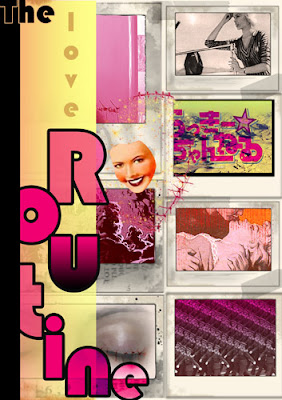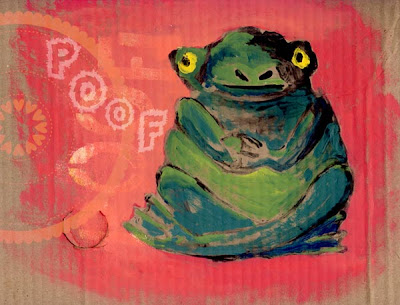 Routine = repetition = safety. For some it is ok, even necessary to be involved with someone just for the sake of the idea. They bask in the safety it provides, not in who they share it with.
Routine = repetition = safety. For some it is ok, even necessary to be involved with someone just for the sake of the idea. They bask in the safety it provides, not in who they share it with.
Tuesday 26 August 2008
Routine
 Routine = repetition = safety. For some it is ok, even necessary to be involved with someone just for the sake of the idea. They bask in the safety it provides, not in who they share it with.
Routine = repetition = safety. For some it is ok, even necessary to be involved with someone just for the sake of the idea. They bask in the safety it provides, not in who they share it with.
Monday 25 August 2008
Untitled_003
 One of the most appealing aspects of art to me, is its sense of tangibility - one of the key senses so easily overlooked(no pun intended). Even though it is an imitation of something - life - it still posesses its corporeal truth.
One of the most appealing aspects of art to me, is its sense of tangibility - one of the key senses so easily overlooked(no pun intended). Even though it is an imitation of something - life - it still posesses its corporeal truth.(We should still have that intriguing conversation about art and imitation.)
Thursday 21 August 2008
Thursday 14 August 2008
Wednesday 13 August 2008
Monday 11 August 2008
Tuesday 5 August 2008
Poof!
Monday 4 August 2008
Sanctity and the image
The subject of this article might seem strange at first, but imagery and religion have been closely interlinked since the first cave paintings by loin clad tribes. From the Aboriginal cave paintings which depicted their culture, beliefs & mythology on overhanging rocks depicting therianthropes (half human half animal figures), to the Bushmen of South Africa to the Egyptians depicting such figures on parchment and hidden inside tombs as gods of the afterlife.
The Aborigines believed that drawing a particular animal would stimulate the species to propagate and that the ritual act of painting or touching these depictions would release sacred energy or power. The Egyptians believed that he who owns a book of the dead will actually be aided/guided by the book and that the spirit gods depicted in the book will arise (or come to life) in aid of the deceased during the journey to the afterlife. Thus the image was not a mere representation of the god, but became the god in the journey of the afterlife.
Something similar is seen with the voodoo cult - where it is believed that the maquette of the person contains their spirit and harm done to it will actually harm the person as well. So the maquette (doll) had some power.
Early Christianity also saw the rise of the iconoclasts during the Byzantine period. They believed the representation of anyone divine (including Jesus and the saints) as icons to be close to idolatory. For iconoclasts, the only real religious image must be an exact likeness of the prototype -of the same substance- which they considered impossible, seeing wood and paint as empty of spirit and life. The iconodules in contrast viewed idols as depicted persons without substance or reality while icons depicted real persons. Essentially the argument was "all religious images not of our faith are idols; all images of our faith are icons to be venerated." This was considered comparable to the Old Testament practice of only offering burnt sacrifices to God, and not to any other gods. They also believed in the acheiropoeiteta (images not created by the hand of men and involved with many miraculous occurences).
One could still argue that even though the iconoclasts and iconodules seemed at opposite ends as to whether it is permitted to visually depict religious content, both acknowledged the power of the image - albeit the one in fear of it’s power and the other acknowledging it.
When one considers that most people (of that historic period before the 1800's) couldn’t read, the impact of images becomes more evident. Then the industrial revolution happened. Faster transport, travel opportunities to never imagined before destinations & the emerging burgeois was the ideal environment for the birth of photography.
Suddenly we had a means to create images more rapidly than ever before - and it was to change the way we see the world irreversibly. Today life would be unimaginable without photography - it is the single medium which influences how we see the world & understand ourselves socially. In fact, we are so overwhelmed by photographic imagery, I wonder whether we still marvel at the wonder of the medium. Does the availability of something make it more valuable? If you knew this was your last day on earth, would it have more value than all the days preceding it?
Just because we are bombarded with photo’s on advertising billboards, or news reels, or in magazines or represenations on tv, or photos of ourselves does it lose its power? Yes and no. Yes, because most people’s attention span is only a fraction long and most reach a point of image saturation quickly - thus anything succeeding it is not even noticed.
Marilyn Monroe, the famous sex symbol (during her time and still today) is quoted for saying: “Hollywood is a place where they'll pay you a thousand dollars for a kiss and fifty cents for your soul.’’
But she was also a woman who knew the power of the image and used the feeble (Hollywood) industry to her advantage. It is well known that she approved all images of herself before being released or published. She also referred to herself as a fantasy (thus a construction, because the definition of fantasy is that which is not real, even though she was a real woman who existed in a certain time). Therefor one could also say no, an abundance of images does not evaporise its power, especially if it is as controlled as Monroe’s representations - then it works together as a body).
I guess what I’m trying to convey is that the image has never lost it’s power. We might only be blinded in thinking so. Images exist much longer in history than the written word, and images supersede any written language in accessibility (thus it is universally understandable regardless of the viewer’s cultural, social background or language). A carefully selected image can still influence the ideas of society - either an advertising billboard with a digitally manipulated body of a model changing the way young women would want to be revered as well as a photojournalist piece of the effects of urbanization on wildlife in China.
The Aborigines believed that drawing a particular animal would stimulate the species to propagate and that the ritual act of painting or touching these depictions would release sacred energy or power. The Egyptians believed that he who owns a book of the dead will actually be aided/guided by the book and that the spirit gods depicted in the book will arise (or come to life) in aid of the deceased during the journey to the afterlife. Thus the image was not a mere representation of the god, but became the god in the journey of the afterlife.
Something similar is seen with the voodoo cult - where it is believed that the maquette of the person contains their spirit and harm done to it will actually harm the person as well. So the maquette (doll) had some power.
Early Christianity also saw the rise of the iconoclasts during the Byzantine period. They believed the representation of anyone divine (including Jesus and the saints) as icons to be close to idolatory. For iconoclasts, the only real religious image must be an exact likeness of the prototype -of the same substance- which they considered impossible, seeing wood and paint as empty of spirit and life. The iconodules in contrast viewed idols as depicted persons without substance or reality while icons depicted real persons. Essentially the argument was "all religious images not of our faith are idols; all images of our faith are icons to be venerated." This was considered comparable to the Old Testament practice of only offering burnt sacrifices to God, and not to any other gods. They also believed in the acheiropoeiteta (images not created by the hand of men and involved with many miraculous occurences).
One could still argue that even though the iconoclasts and iconodules seemed at opposite ends as to whether it is permitted to visually depict religious content, both acknowledged the power of the image - albeit the one in fear of it’s power and the other acknowledging it.
When one considers that most people (of that historic period before the 1800's) couldn’t read, the impact of images becomes more evident. Then the industrial revolution happened. Faster transport, travel opportunities to never imagined before destinations & the emerging burgeois was the ideal environment for the birth of photography.
Suddenly we had a means to create images more rapidly than ever before - and it was to change the way we see the world irreversibly. Today life would be unimaginable without photography - it is the single medium which influences how we see the world & understand ourselves socially. In fact, we are so overwhelmed by photographic imagery, I wonder whether we still marvel at the wonder of the medium. Does the availability of something make it more valuable? If you knew this was your last day on earth, would it have more value than all the days preceding it?
Just because we are bombarded with photo’s on advertising billboards, or news reels, or in magazines or represenations on tv, or photos of ourselves does it lose its power? Yes and no. Yes, because most people’s attention span is only a fraction long and most reach a point of image saturation quickly - thus anything succeeding it is not even noticed.
Marilyn Monroe, the famous sex symbol (during her time and still today) is quoted for saying: “Hollywood is a place where they'll pay you a thousand dollars for a kiss and fifty cents for your soul.’’
But she was also a woman who knew the power of the image and used the feeble (Hollywood) industry to her advantage. It is well known that she approved all images of herself before being released or published. She also referred to herself as a fantasy (thus a construction, because the definition of fantasy is that which is not real, even though she was a real woman who existed in a certain time). Therefor one could also say no, an abundance of images does not evaporise its power, especially if it is as controlled as Monroe’s representations - then it works together as a body).
I guess what I’m trying to convey is that the image has never lost it’s power. We might only be blinded in thinking so. Images exist much longer in history than the written word, and images supersede any written language in accessibility (thus it is universally understandable regardless of the viewer’s cultural, social background or language). A carefully selected image can still influence the ideas of society - either an advertising billboard with a digitally manipulated body of a model changing the way young women would want to be revered as well as a photojournalist piece of the effects of urbanization on wildlife in China.
Subscribe to:
Posts (Atom)




